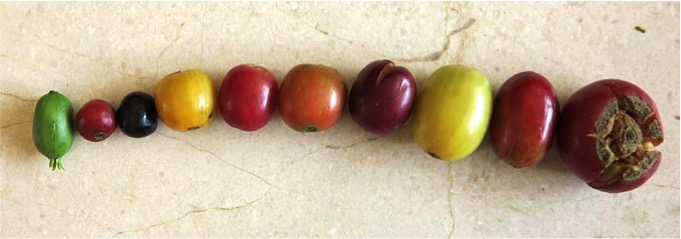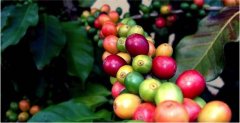Genetic chromosome and Factor mutations in Coffee plants
For professional baristas, please follow the coffee workshop (Wechat official account cafe_style)

The heredity of Coffea
The heredity of the genus Coffee is very complex, and its chromosome number is mostly 2n=22 except that Arabica coffee is 2n=4x=44 (heterotetrad). Medium-grain coffee (Coffea canephora, 2n=2x = 22) grows well and can be used as a genetic research material. All of the above mutations are a pair of factors, while many other pairs of factor mutations have not been found.
The chromosomes in the Prophase of meiosis are heterochromic, the staining near the centrosome is darker, and the staining of other parts is lighter.
With the exception of Arabica coffee from the Ethiopian highlands, 90% of Arabica coffee is self-compatible, and all other types of coffee are self-infertile. After several generations of self-breeding, the growth potential and yield of Elaraby coffee were not affected.
Arabica coffee has more mutations, which may be due to its easy selfing and recessive mutations.
The chromosome mutations in Arabica coffee are
a. Six elements (2n=66) Bullata form. The leaf is thicker and wider than the quaternary, with fewer stomata and less fruit.
b. Octet (2n=88) Bullata form.
Leaves are smaller, thicker and tougher than hexagons, with fewer pores and stronger.
And less.
c. Binary (2n=22) Monosperma form.
The leaf is thinner and narrower than the binary, with more stomata and less fruit.
Only one seed per fruit.
d. Chromosome variation of somatic cells.
The factor mutations of Arabica coffee are
a. About 1/3 of the known mutations are dominant, 1/3 are incomplete dominant and 1/3 are recessive.
b. There are also good offspring in recessive mutation: Typica → bourbon Bourbon → Laurina Bourbon → Semperflorens.
c. Dominant mutations such as maragogype and Caturra.
d. Most mutations have the power to affect the whole plant (Pleiotropic), such as narrow leaf mutation, deformed mutation A, deformed mutation B, wrinkled leaf mutation, brown leaf mutation, short branch leaflet mutation, purple leaf mutation, calyx mutation, multi-flower mutation, large calyx mutation, dwarf mutation, yellow endosperm mutation, orthophytic mutation, tufted mutation, large mutation, small mutation, yellow fruit mutation, Lloyd's coffee. Normal coffee and so on.
e. All the factors were very stable, only the abrupt change of short branch and leaflet showed the appearance of intermediate type, but it was also very obvious.
f. Factor epistasis and interaction have been found.
g. The study of mutations is of great value, and some mutations have been bred into economic varieties.
h. This kind of study can explore the source of cultivated varieties. For example, bourbon is from typica.
Important Notice :
前街咖啡 FrontStreet Coffee has moved to new addredd:
FrontStreet Coffee Address: 315,Donghua East Road,GuangZhou
Tel:020 38364473
- Prev

A variety [Ethiopian Heirloom] Yirgacheffe evolved from Arabica species
Exchange of professional baristas Please pay attention to the coffee workshop (Wechat official account cafe_style) from the Arabica species evolved from the variety [Ethiopian Heirloom] Yirgacheffe Ethiopia Heirloom coffee population, can be said to be the most distinctive and delicious coffee in the world, the beauty of this variety lies in their mystery. They are wild flowers, from Ethiopia.
- Next

Analysis and summary of genetic variation of coffee plants
Professional baristas exchange please pay attention to the coffee workshop (Wechat official account cafe_style) narrow leaf mutation Angustifolia leaves long and narrow, long lanceolate leaf varieties are the main parent source of coffee breeding. About 5% of C. arabica seedlings have narrow leaves. The recessive factor of two pairs of mutations of ag1 and ag2 was crossed with normal plant. The first generation was normal and the second generation was 9 positive.
Related
- Does Rose Summer choose Blue, Green or Red? Detailed explanation of Rose Summer Coffee plots and Classification in Panamanian Jade Manor
- What is the difference between the origin, producing area, processing plant, cooperative and manor of coffee beans?
- How fine does the espresso powder fit? how to grind the espresso?
- Sca coffee roasting degree color card coffee roasting degree 8 roasting color values what do you mean?
- The practice of lattes: how to make lattes at home
- Introduction to Indonesian Fine Coffee beans-- Java Coffee producing area of Indonesian Arabica Coffee
- How much will the flavor of light and medium roasted rose summer be expressed? What baking level is rose summer suitable for?
- Introduction to the characteristics of washing, sun-drying or wet-planing coffee commonly used in Mantenin, Indonesia
- Price characteristics of Arabica Coffee Bean Starbucks introduction to Manning Coffee Bean Taste producing area Variety Manor
- What is the authentic Yega flavor? What are the flavor characteristics of the really excellent Yejasuffi coffee beans?

